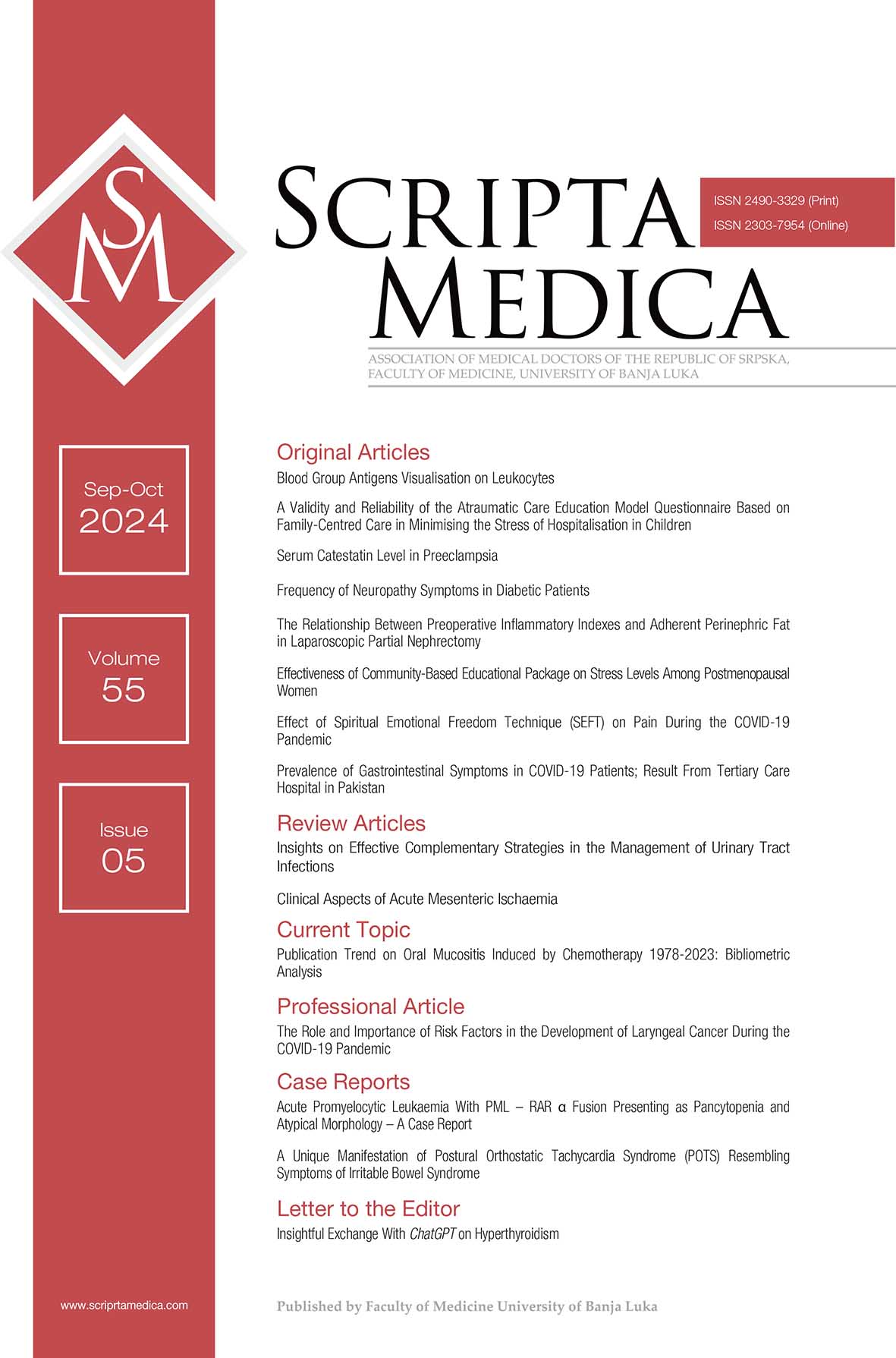Serum Catestatin Level in Preeclampsia
Sažetak
Background/Aim: Preeclampsia, a significant cause of maternal morbidity and mortality, is linked to increased cardiovascular risks. Catestatin regulates cardiovascular function which indicates its usefulness in understanding pathophysiology of preeclampsia and its severity. Aim of this study was to evaluate association of catestatin in preeclamptic women and control non preeclamptic women and assess its association with presence and severity of preeclampsia.
Methods: A case-control study at Al-Zahraa Teaching Hospital, Iraq, performed from January to December 2023 involved 90 pregnant women: 30 with severe preeclampsia, 30 with mild preeclampsia and 30 healthy controls. Inclusion criteria were preeclamptic pregnant women at 27-40 weeks of gestation and age ranging from 20-40 years and similar non-eclamptic controls. Exclusions were smokers, chronic drug users and those with chronic illnesses. Data collection included general and clinical information, BMI, vital signs, examinations and laboratory tests including serum catestatin.
Results: Catestatin levels varied significantly among severe preeclampsia, mild preeclampsia and control groups. Average catestatin level in severe preeclampsia group was markedly lower at 29.01, compared to 43.67 in mild preeclampsia and 59.96 in controls. The diagnostic performance of catestatin for severe preeclampsia was notable, with a cutoff point of ≤ 37.165, sensitivity of 80 % and specificity of 83.3 %, highlighting its potential as a critical biomarker in preeclampsia evaluation.
Conclusion: Catestatin level was significantly lower in sever preeclampsia compared to mild and control group, which may indicate its association with preeclampsia. Lower catestatin in sever preeclampsia suggest its inverse relation with preeclampsia severity.
Reference
Bourebaba Y, Mularczyk M, Marycz K, Bourebaba L. Catestatin peptide of chromogranin A as a potential new target for several risk factors management in the course of metabolic syndrome. Biomed Pharmacother. 2021 Feb;134:111113. doi: 10.1016/j.biopha.2020.111113.
Zalewska E, Kmieć P, Sworczak K. Role of catestatin in the cardiovascular system and metabolic disorders. Front Cardiovasc Med. 2022 May 19;9:909480. doi: 10.3389/fcvm.2022.909480.
Özalp M, Yaman H, Demir Ö, Garip SA, Aran T, Osmanağaoğlu MA. The role of maternal serum catestatin in the evaluation of preeclampsia and fetal cardiac functions. Turk J Obstet Gynecol. 2021 Dec 24;18(4):272-8. doi: 10.4274/tjod.galenos.2021.34946.
Mahata SK, Kiranmayi M, Mahapatra NR. Catestatin: a master regulator of cardiovascular functions. Curr Med Chem. 2018;25(11):1352-74. doi: 10.2174/0929867324666170425100416.
Tüten N, Güralp O, Gök K, Hamzaoglu K, Oner YO, Makul M, et al. Serum catestatin level is increased in women with preeclampsia. J Obstet Gynaecol. 2022 Jan;42(1):55-60. doi: 10.1080/01443615.2021.1873922.
Centers for Disease C, Prevention [Internet]. Assessing your weight. Division of Nutrition, Physical Activity, and Obesity. 2015. [Accessed: 31-Dec-2023]. Aailable at: https://www.cdc.gov/cdi/indicator-definitions/npao.html.
Hypertension in pregnancy: diagnosis and management. London: National Institute for Health and Care Excellence (NICE); 2019 Jun 25. (NICE Guideline, No. 133.) [Accessed: 31-Dec-2023]. Aailable at: https://www.ncbi.nlm.nih.gov/books/NBK546004/.
Palmrich P, Schirwani-Hartl N, Haberl C, Haslinger P, Heinzl F, Zeisler H, et al. Catestatin-A potential new therapeutic target for women with preeclampsia? An analysis of maternal serum catestatin levels in preeclamptic pregnancies. J Clin Med. 2023 Sep 12;12(18):5931. doi: 10.3390/jcm12185931.
Sheen J-J, Huang Y, Andrikopoulou M, Wright JD, Goffman D, D'Alton ME, et al. Maternal age and preeclampsia outcomes during delivery hospitalizations. Am J Perinatol. 2020 Jan;37(1):44-52. doi: 10.1055/s-0039-1694794.
Khalil A, Syngelaki A, Maiz N, Zinevich Y, Nicolaides KH. Maternal age and adverse pregnancy outcome: a cohort study. Ultrasound Obstet Gynecol. 2013 Dec;42(6):634-43. doi: 10.1002/uog.12494.
Wadhwani P, Saha PK, Kalra JK, Gainder S, Sundaram V. A study to compare maternal and perinatal outcome in early vs. late onset preeclampsia. Obstet Gynecol Sci. 2020 May;63(3):270-7. doi: 10.5468/ogs.2020.63.3.270.
Miller EC, Wilczek A, Bello NA, Tom S, Wapner R, Suh Y. Pregnancy, preeclampsia and maternal aging: From epidemiology to functional genomics. Ageing Res Rev. 2022 Jan;73:101535. doi: 10.1016/j.arr.2021.101535.
Robillard P-Y, Dekker G, Scioscia M, Bonsante F, Iacobelli S, Boukerrou M, et al. Increased BMI has a linear association with late-onset preeclampsia: A population-based study. PLoS One. 2019 Oct 17;14(10):e0223888. doi: 10.1371/journal.pone.0223888.
Jiang L, Lin J, Yan J, Lin X, Han Q, Zhang H. Prepregnancy body mass indexes are associated with perinatal outcomes in females with preeclampsia. Exp Ther Med. 2020 Jul;20(1):500-4. doi: 10.3892/etm.2020.8677.
Lisonkova S, Bone JN, Muraca GM, Razaz N, Wang LQ, Sabr Y, et al. Incidence and risk factors for severe preeclampsia, hemolysis, elevated liver enzymes, and low platelet count syndrome, and eclampsia at preterm and term gestation: a population-based study. Am J Obstet Gynecol. 2021 Nov;225(5):538.e1-538.e19. doi: 10.1016/j.ajog.2021.04.261.
Yang SW, Cho SH, Kwon HS, Sohn IS, Hwang HS. Significance of the platelet distribution width as a severity marker for the development of preeclampsia. Eur J Obstet Gynecol Reprod Biol. 2014 Apr;175:107-11. doi: 10.1016/j.ejogrb.2013.12.036.
Charles N, Amarachukwu N, Ekpo E, Cajethan E. Changes in renal function among women with preeclampsia in a tertiary health institution in Nigeria. Int J Womens Health Rep Sci. 2020;8(3):272-5. doi: 10.15296/ijwhr.2020.44.
Munazza B, Raza N, Naureen A, Khan SA, Fatima F, Ayub M, et al. Liver function tests in preeclampsia. J Ayub Med Coll Abbottabad. 2011 Oct-Dec;23(4):3-5. PMID: 23472397.
Bralewska M, Biesiada L, Grzesiak M, Rybak-Krzyszkowska M, Huras H, Gach A, et al. Chromogranin A demonstrates higher expression in preeclamptic placentas than in normal pregnancy. BMC Pregnancy Childbirth. 2021 Oct 7;21(1):680. doi: 10.1186/s12884-021-04139-z.
- Authors retain copyright and grant the journal right of first publication with the work simultaneously licensed under a Creative Commons Attribution License that allows others to share the work with an acknowledgement of the work's authorship and initial publication in this journal.
- Authors are able to enter into separate, additional contractual arrangements for the non-exclusive distribution of the journal's published version of the work (e.g., post it to an institutional repository or publish it in a book), with an acknowledgement of its initial publication in this journal.
- Authors are permitted and encouraged to post their work online (e.g., in institutional repositories or on their website) prior to and during the submission process, as it can lead to productive exchanges, as well as earlier and greater citation of published work (See The Effect of Open Access).

